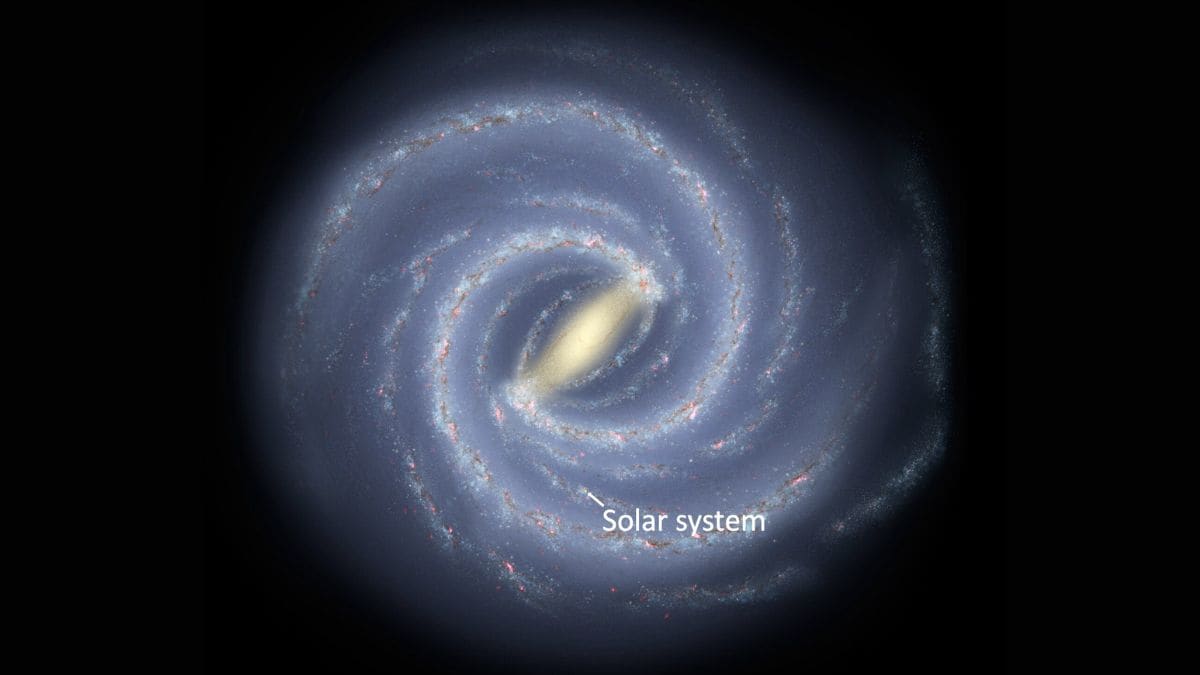Solar system passed through Orion, says intriguing new study


- Our solar system passed through a star-forming region in the direction of the Orion constellation around 14 million years ago.
- We traveled through what’s called the Radcliffe Wave, a gaseous structure in the Orion Arm of the Milky Way, which contains stellar nurseries.
- This passage coincided with the Middle Miocene Climate Transition, a period of climatic change. It’s possible the influx of interstellar dust might have played a role.
The solar system passed through the Orion star-forming region
Our solar system – our sun and its family of planets – moves through space. As our Milky Way galaxy rotates, the sun and its planets move around the galactic center. Scientists recently reported that, about 14 million years ago, the solar system passed through a star-forming region now located in the direction of the constellation we know as Orion the Hunter. They said that as it moved through this dense region of dust and gas, some of that dust might have affected Earth’s climate.
The researchers published their findings in the journal Astronomy & Astrophysics on February 11, 2025.
Efrem Maconi, the paper’s lead author, said in a statement:
Imagine it like a ship sailing through varying conditions at sea. Our sun encountered a region of higher gas density as it passed through the Radcliffe Wave in the Orion constellation.
EarthSky’s founder Deborah Byrd hosted this livestream about the constellation Orion … and our place in the Milky Way galaxy … in January 2025.
The 2025 EarthSky lunar calendar makes a great gift. Get yours today!
The Radcliffe Wave and its star-forming regions
The Milky Way galaxy is shaped like a spiral with arms wrapped around the center. Our sun’s family is located about halfway between the center and the visible edge of the galaxy, in a spiral arm known as the Orion Arm, sometimes called the Local Arm.
In the Orion Arm, there’s a gaseous structure called the Radcliffe Wave. It’s about 8,800 light-years long. Along this structure are many interconnected stellar nurseries, that is, dense gaseous complexes where stars are being formed.
One of those stellar nurseries in the Radcliffe Wave is the Orion star-forming complex. It’s an area of dense interstellar dust and gas that has regions of active star formation. In the sky, it lies in the direction of the much-loved constellation Orion the Hunter. Orion is a fixture of northern hemisphere winter – and southern hemisphere summer – evening skies.

Our solar system passed through the Orion region
Scientists used observations from the recently retired Gaia mission to backtrack through the solar system’s travels in the Orion region of the Radcliffe Wave. They used precise measurements of the motions of stars in open star clusters located in that region. (Open star clusters are collections of young stars that recently emerged from their star-forming cocoons of dust and gas.)
Paper co-author, João Alves, said:
We passed through the Orion region as well-known star clusters like NGC 1977, NGC 1980, and NGC 1981 were forming. This region is easily visible in the winter sky in the Northern Hemisphere and summer in the Southern Hemisphere. Look for the Orion constellation and the Orion Nebula (Messier 42). Our solar system came from that direction!

Moving through dense gas and dust
The scientists found that from 18 million to 11.5 million years ago, the sun and its planets journeyed through the Orion star-forming complex, a gas- and dust-dense region of space. An interactive graphic using data from Gaia and computer models is available at this page.
Our sun emits a steady stream of plasma known as solar wind. Together with the sun’s magnetic field, it forms the heliosphere, a protective bubble that mostly shields the solar system from the interstellar medium, dust and gas between the stars.
During the sun’s passage through the Orion star-forming complex, the heliosphere may have become compressed, increasing the influx of interstellar dust into the solar system.
This dust could have fallen into Earth’s atmosphere. And therefore, it could have left traces of radioactive elements that originated from supernovae in the geological record.
Alves said:
While current technology may not be sensitive enough to detect these traces, future detectors could make it possible.

How did passage through the Orion region affect the Earth’s climate?
The sun’s journey through the Orion region occurred from 18 to 11.5 million years ago. And our solar system was in the densest regions of the clouds between 15 and 12 million years ago.
This timeframe coincides with the Middle Miocene Climate Transition. During this period, around 14 million years ago, there was a significant climatic change from warm conditions to a cooler climate.
Could the influx of interstellar dust have caused this climate shift? The scientists don’t know for sure, and they say it needs further investigation.
Maconi commented:
While the underlying processes responsible for the Middle Miocene Climate Transition are not entirely identified, the available reconstructions suggest that a long-term decrease in the atmospheric greenhouse gas carbon dioxide concentration is the most likely explanation, although large uncertainties exist. However, our study highlights that interstellar dust related to the crossing of the Radcliffe Wave might have impacted Earth’s climate and potentially played a role during this climate transition. To alter the Earth’s climate the amount of extraterrestrial dust on Earth would need to be much bigger than what the data so far suggest.
Future research will explore the significance of this contribution. It’s crucial to note that this past climate transition and current climate change are not comparable since the Middle Miocene Climate Transition unfolded over timescales of several hundred thousand years. In contrast, the current global warming evolution is happening at an unprecedented rate over decades to centuries due to human activity.










































